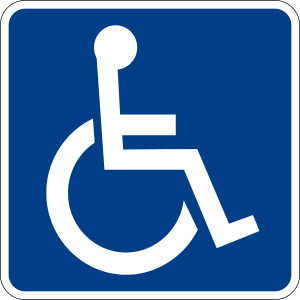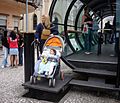Accessibility facts for kids

Accessibility means making sure everyone, including people with disabilities, can use and enjoy places, information, and services equally. It's about giving people with disabilities the same chances as everyone else. This way, they can take part in society fully.
Think of it this way: if a place or a service is accessible, it means anyone can use it easily. This is true whether they use a wheelchair, have trouble hearing, or can't see well.
Here are some examples of accessibility:
- Buildings often have ramps for people using wheelchairs or scooters.
- TVs and DVDs have close captioning or subtitles for people who are deaf or hard of hearing.
- Sign language helps deaf people talk to others.
- Braille helps people who are blind read books and signs.
- Special computer software and hardware let people with disabilities use computers and the Internet.
The idea of accessibility is very important. It is mentioned in the Convention on the Rights of Persons with Disabilities. This is a special agreement that talks about the rights of people with disabilities.
Contents
Why is Accessibility Important?
Accessibility is important because it helps everyone be included. When places and services are accessible, people with disabilities can:
- Go to school and learn.
- Find jobs and work.
- Visit friends and family.
- Enjoy parks, shops, and public places.
- Get information and communicate easily.
It helps build a fair and equal society for all.
Different Types of Accessibility
Accessibility can be about many different things. It's not just about ramps!
Physical Accessibility
This is about making physical places easy to use.
- Ramps and elevators: These help people in wheelchairs move between different levels.
- Wide doorways: These allow wheelchairs and mobility aids to pass through easily.
- Accessible restrooms: These have space and grab bars for easier use.
- Tactile paving: These are special bumpy paths on sidewalks. They help people who are blind know where they are going.
Digital Accessibility
This focuses on making websites, apps, and online information easy to use.
- Screen readers: These programs read out loud what is on a computer screen. They help people who are blind use computers.
- Keyboard navigation: This allows people to use a website without a mouse. This helps those who cannot use a mouse easily.
- Captions and transcripts: These are text versions of videos and audio. They help people who are deaf or hard of hearing.
- Clear design: Websites should be easy to understand and navigate for everyone.
Communication Accessibility
This is about making sure everyone can share and receive information.
- Sign language interpreters: These people translate spoken language into sign language.
- Easy-to-read documents: Information should be written in simple language. This helps people with learning disabilities.
- Large print: Books and documents can be printed in bigger letters. This helps people with low vision.
Accessibility in Daily Life
You can see accessibility all around you.
- Public transport: Buses, trains, and subways often have ramps or lifts. They also have spaces for wheelchairs.
- Schools: Many schools now have accessible classrooms and playgrounds.
- Shops and restaurants: These places often have accessible entrances and restrooms.
- Parks: Some parks have accessible paths and play areas.
Making things accessible benefits everyone, not just people with disabilities. For example, ramps are great for strollers too!
Related pages
Images for kids
-
This Birmingham, West Midlands, Opportunities Fair was held to help persons with disabilities, and carers, to find out what services, support and opportunities are available to them.
-
William P. Milton Jr., deputy director, Office of Human Resources Management explained the "Four Easy Steps to Hiring Qualified Applicants with Disabilities" to United States Department of Agriculture employees during a 2011 National Disability Employment Awareness Month event in Washington, DC, USA.
-
A wheelchair accessible taxi with a rear ramp, Tokyo Motor Show 2009
-
A teacher helps her student at an orphanage in central Vietnam. The orphanage caters to many abandoned and disabled children – through education and communication programs they are able to have a life that would otherwise not be possible.
See also
 In Spanish: Accesibilidad para niños
In Spanish: Accesibilidad para niños










